SUBARU BRZ 2017 1.G Owners Manual
Manufacturer: SUBARU, Model Year: 2017, Model line: BRZ, Model: SUBARU BRZ 2017 1.GPages: 540, PDF Size: 6.88 MB
Page 111 of 540
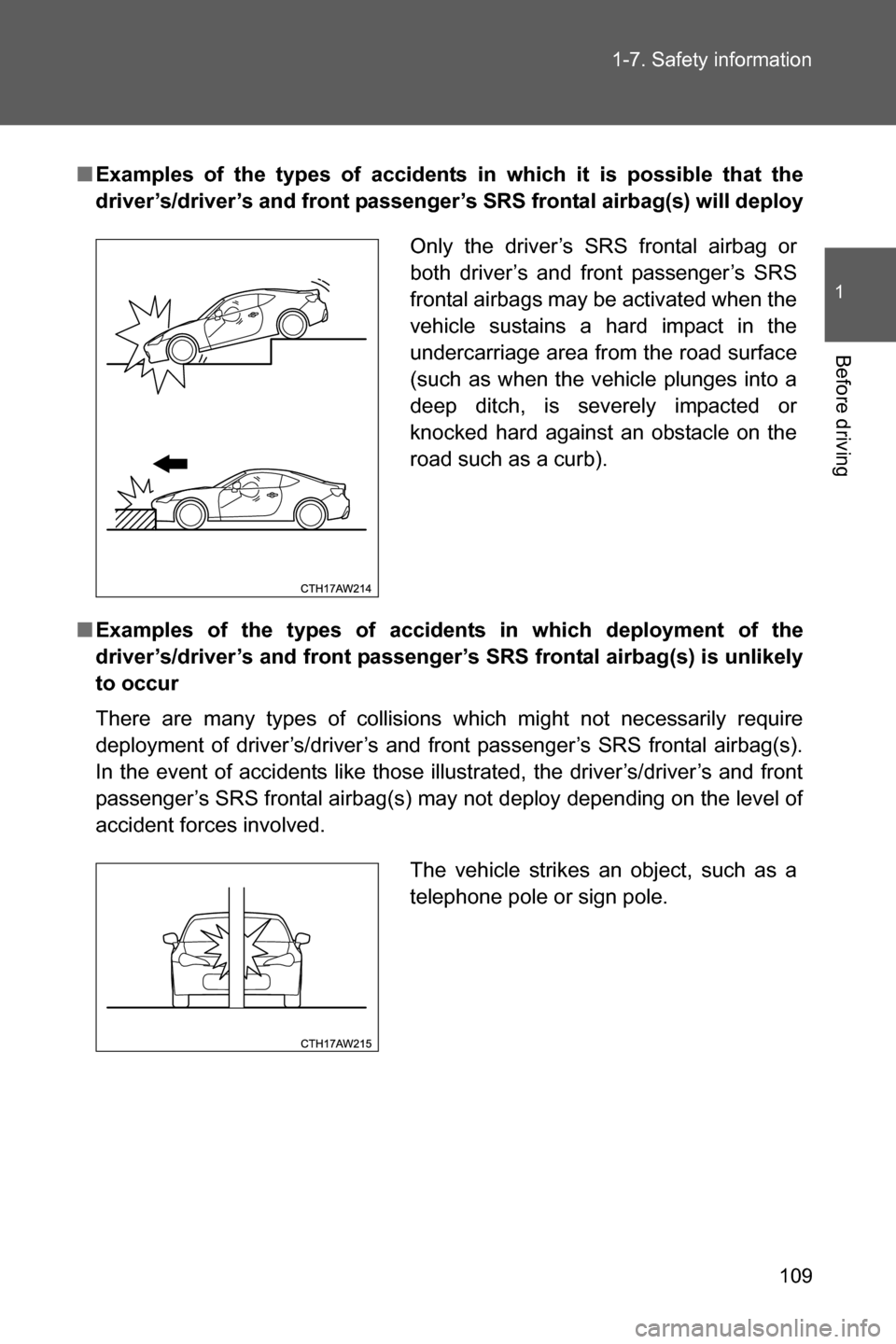
109 1-7. Safety information
1
Before driving
■Examples of the types of accidents in which it is possible that the
driver’s/driver’s and front passenger’s SRS frontal airbag(s) will deploy
■Examples of the types of accidents in which deployment of the
driver’s/driver’s and front passenger’s SRS frontal airbag(s) is unlikely
to occur
There are many types of collisions which might not necessarily require
deployment of driver’s/driver’s and front passenger’s SRS frontal airbag(s).
In the event of accidents like those illustrated, the driver’s/driver’s and front
passenger’s SRS frontal airbag(s) may not deploy depending on the level of
accident forces involved.Only the driver’s SRS frontal airbag or
both driver’s and front passenger’s SRS
frontal airbags may be activated when the
vehicle sustains a hard impact in the
undercarriage area from the road surface
(such as when the vehicle plunges into a
deep ditch, is severely impacted or
knocked hard against an obstacle on the
road such as a curb).
The vehicle strikes an object, such as a
telephone pole or sign pole.
Page 112 of 540
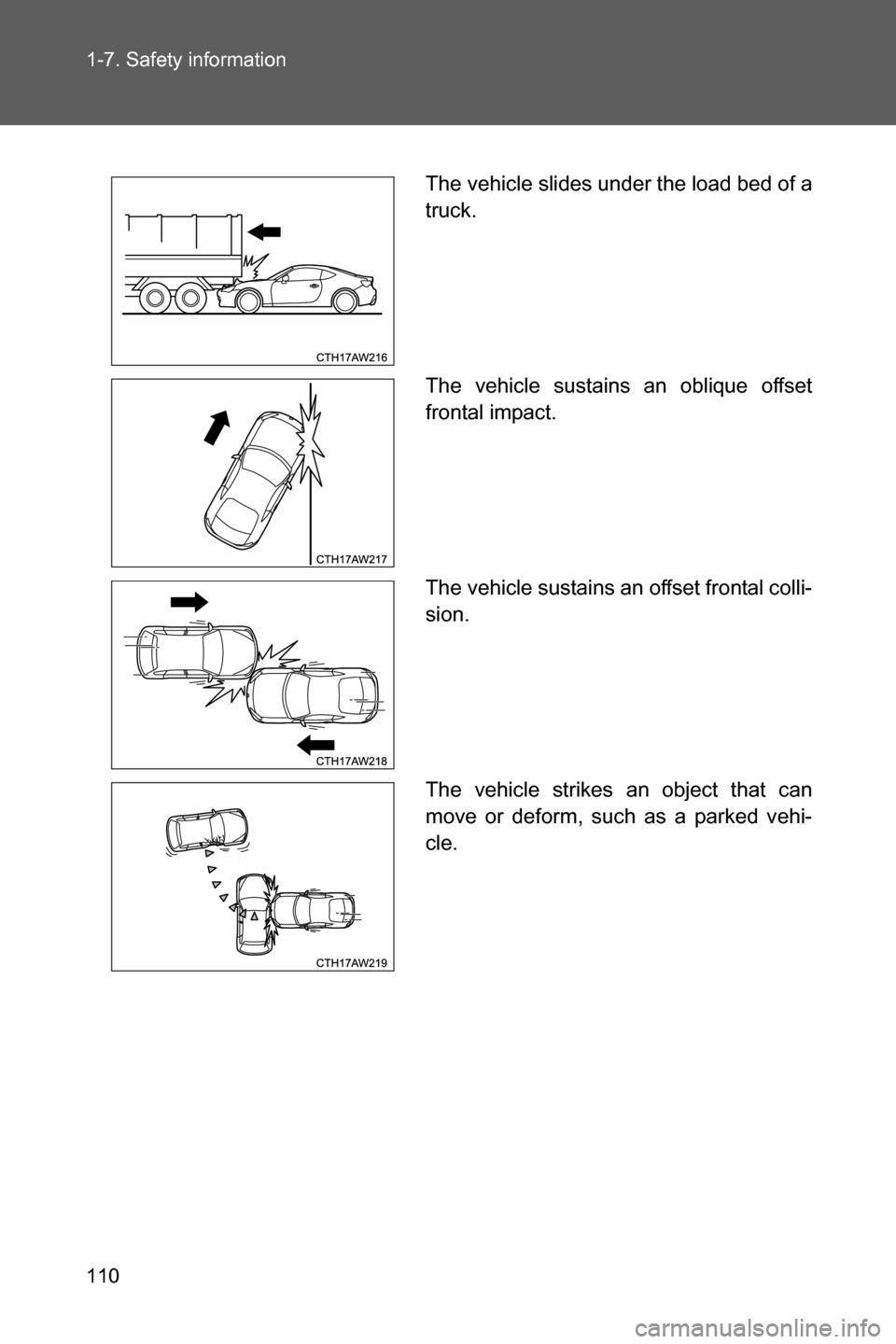
110 1-7. Safety information
The vehicle slides under the load bed of a
truck.
The vehicle sustains an oblique offset
frontal impact.
The vehicle sustains an offset frontal colli-
sion.
The vehicle strikes an object that can
move or deform, such as a parked vehi-
cle.
Page 113 of 540
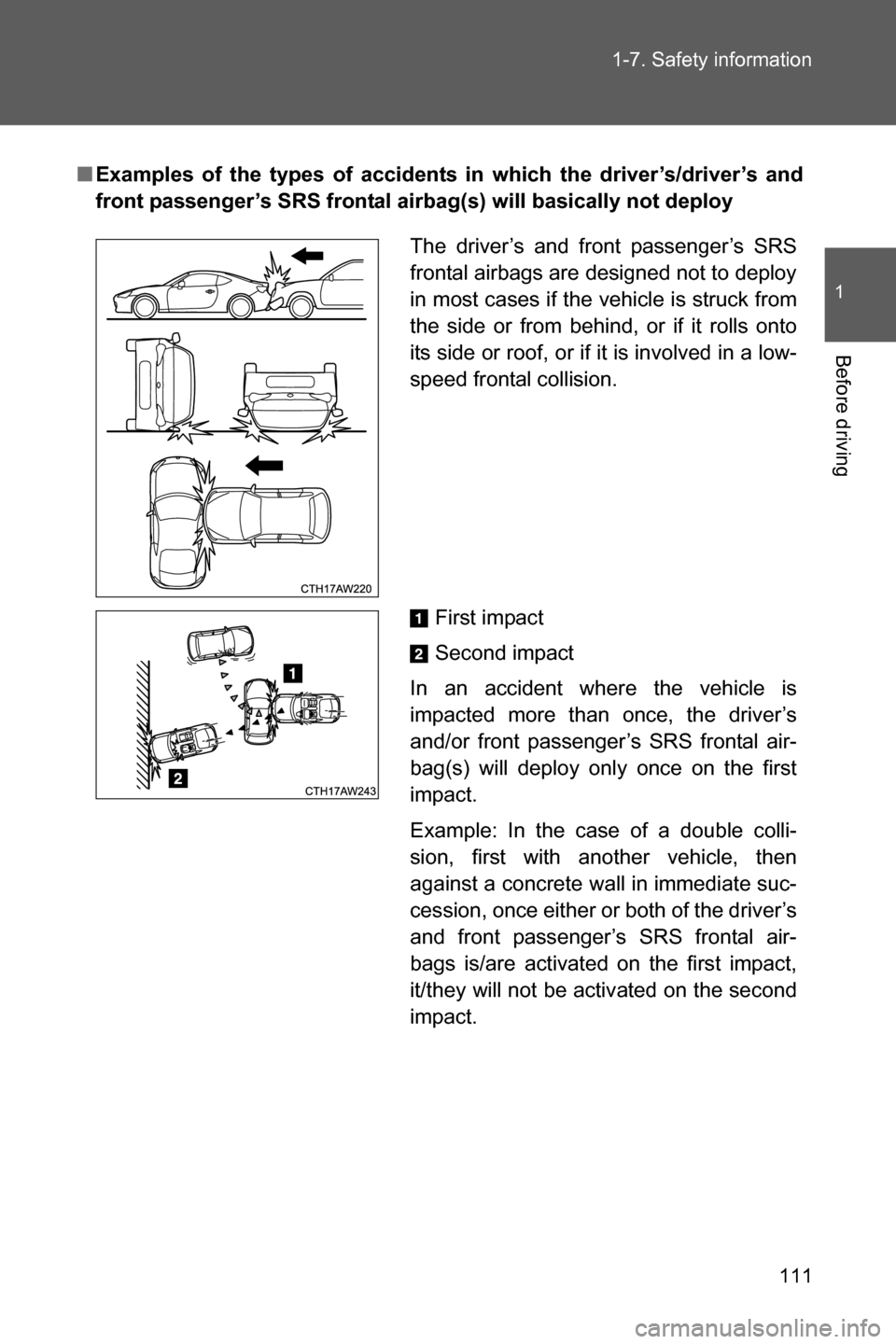
111 1-7. Safety information
1
Before driving
■Examples of the types of accidents in which the driver’s/driver’s and
front passenger’s SRS frontal airbag(s) will basically not deploy
The driver’s and front passenger’s SRS
frontal airbags are designed not to deploy
in most cases if the vehicle is struck from
the side or from behind, or if it rolls onto
its side or roof, or if it is involved in a low-
speed frontal collision.
First impact
Second impact
In an accident where the vehicle is
impacted more than once, the driver’s
and/or front passenger’s SRS frontal air-
bag(s) will deploy only once on the first
impact.
Example: In the case of a double colli-
sion, first with another vehicle, then
against a concrete wall in immediate suc-
cession, once either or both of the driver’s
and front passenger’s SRS frontal air-
bags is/are activated on the first impact,
it/they will not be activated on the second
impact.
Page 114 of 540

112 1-7. Safety information
WARNING
■If the SRS airbags deploy
Do not touch the SRS airbag system components around the steering wheel
and dashboard with bare hands right after deployment. Doing so can cause
burns because the components can be very hot as a result of deployment.
■Child restraint precautions
NEVER INSTALL A REARWARD FACING CHILD SEAT IN THE FRONT
PASSENGER’S SEAT EVEN IF THE FRONT PASSENGER’S SRS FRON-
TAL AIRBAG IS DEACTIVATED. Be sure to install it in the REAR seat in a
correct manner. Also, it is strongly recommended that any forward facing
child seat or booster seat be installed in the REAR seat, and that even chil-
dren who have outgrown a child restraint system be also seated in the
REAR seat. This is because children sitting in the front passenger’s seat
may be killed or severely injured should the front passenger’s SRS frontal
airbag deploy. REAR seats are the safest place for children.
Page 115 of 540

113 1-7. Safety information
1
Before driving
SRS side airbag and SRS curtain airbag
The SRS side airbag is stored in the door side of each front seat
seatback, which bears an “SRS AIRBAG” label.
In a moderate to severe side impact collision, the SRS side airbag on
the impacted side of the vehicle deploys between the occupant and
the door panel and supplements the seatbelt by reducing the impact
on the occupant’s chest and waist. The SRS side airbag operates
only for front seat occupants.
The SRS curtain airbag on each side of the cabin is stored in the roof
side (between the front pillar and a point over the rear seat). An “SRS
AIRBAG” mark is located at the top of each front and rear pillar.
In a moderate to severe side impact collision, the SRS curtain airbag
on the impacted side of the vehicle deploys between the occupant
and the side window and supplements the seatbelt by reducing the
impact on the occupant’s head.
If the vehicle is extremely inclined such as when it is involved in a roll-
over accident, the SRS curtain airbags will deploy along with the
driver’s and front passenger’s seatbelt pretensioners to help reduce
the impact to the occupants’ heads.
Your vehicle is equipped with a SUBARU SRS curtain airbag system
that complies with Federal Motor Safety Standard (FMVSS) No. 226.
Page 116 of 540
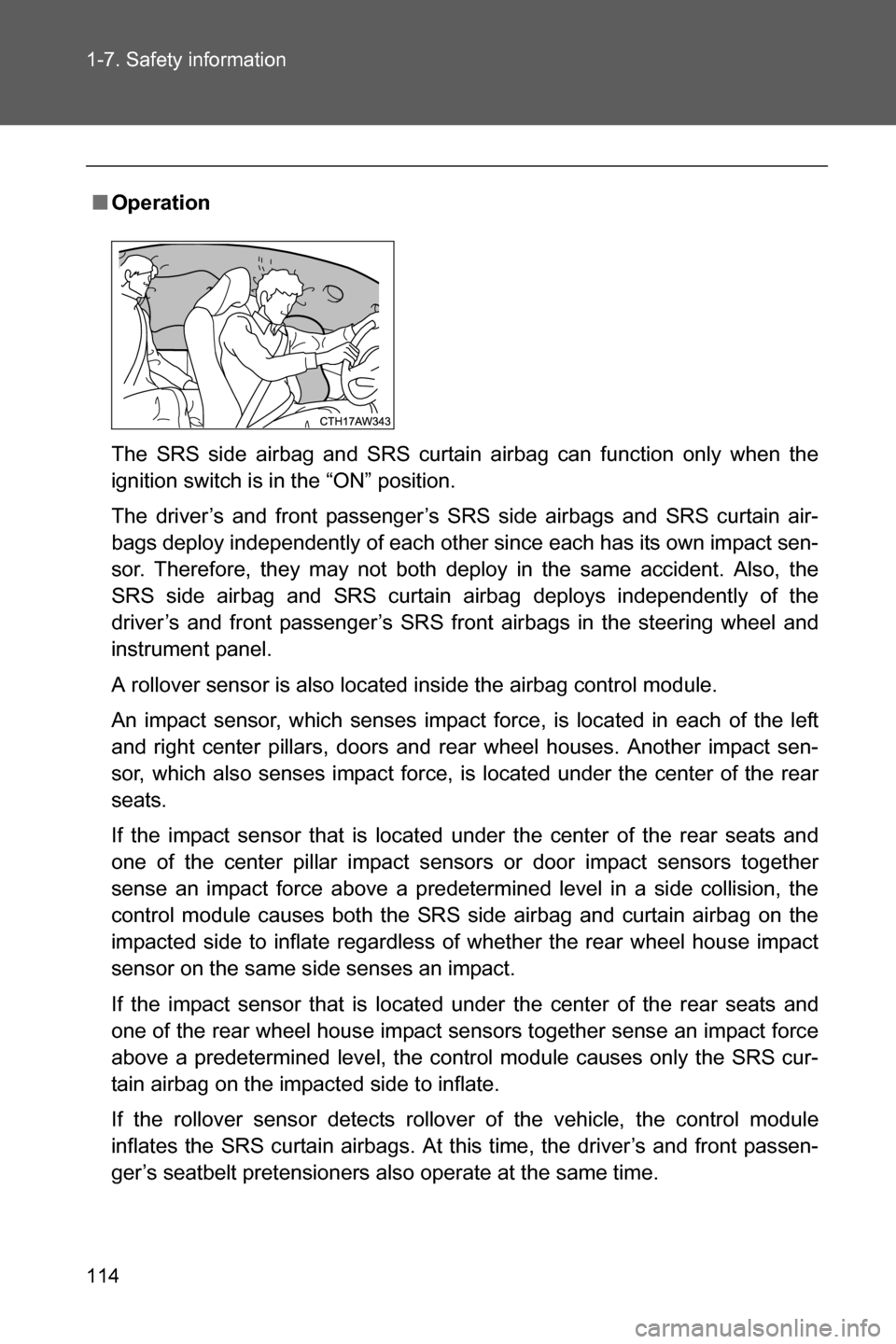
114 1-7. Safety information
■Operation
The SRS side airbag and SRS curtain airbag can function only when the
ignition switch is in the “ON” position.
The driver’s and front passenger’s SRS side airbags and SRS curtain air-
bags deploy independently of each other since each has its own impact sen-
sor. Therefore, they may not both deploy in the same accident. Also, the
SRS side airbag and SRS curtain airbag deploys independently of the
driver’s and front passenger’s SRS front airbags in the steering wheel and
instrument panel.
A rollover sensor is also located inside the airbag control module.
An impact sensor, which senses impact force, is located in each of the left
and right center pillars, doors and rear wheel houses. Another impact sen-
sor, which also senses impact force, is located under the center of the rear
seats.
If the impact sensor that is located under the center of the rear seats and
one of the center pillar impact sensors or door impact sensors together
sense an impact force above a predetermined level in a side collision, the
control module causes both the SRS side airbag and curtain airbag on the
impacted side to inflate regardless of whether the rear wheel house impact
sensor on the same side senses an impact.
If the impact sensor that is located under the center of the rear seats and
one of the rear wheel house impact sensors together sense an impact force
above a predetermined level, the control module causes only the SRS cur-
tain airbag on the impacted side to inflate.
If the rollover sensor detects rollover of the vehicle, the control module
inflates the SRS curtain airbags. At this time, the driver’s and front passen-
ger’s seatbelt pretensioners also operate at the same time.
Page 117 of 540

115 1-7. Safety information
1
Before driving
After the deployment, the SRS side airbag immediately starts to deflate. The
time required from detection of an impact to deflation of an SRS side airbag
after deployment is shorter than the blink of an eye.
The SRS curtain airbag remains inflated for a while following deployment
then slowly deflates.
The SRS side airbag and SRS curtain airbag deploy even when no one
occupies the seat on the side on which an impact is applied.
When the SRS side airbag and SRS curtain airbag deploy, a sudden, fairly
loud inflation noise will be heard and some smoke will be released. These
occurrences are a normal result of the deployment. This smoke does not
indicate a fire in the vehicle.
The SRS side airbag and SRS curtain airbag are designed to deploy in the
event of an accident involving a moderate to severe side impact collision.
They are not designed to deploy in most lesser side impact. Also, they are
not designed to deploy in most frontal or most rear impacts because SRS
side airbag and SRS curtain airbag deployment would not help the occupant
in those situations.
The SRS curtain airbags are also designed to deploy when the vehicle is in
an extremely inclined state such as during a rollover. They are not designed
to deploy in most lesser inclined state.
Each SRS side airbag and SRS curtain airbag are designed to function on a
one-time-only basis.
SRS side airbag and SRS curtain airbag deployment depend on the level of
force experienced in the passenger compartment during a side impact colli-
sion. That level differs from one type of collision to another, and it may have
no bearing on the visible damage done to the vehicle itself.
Page 118 of 540
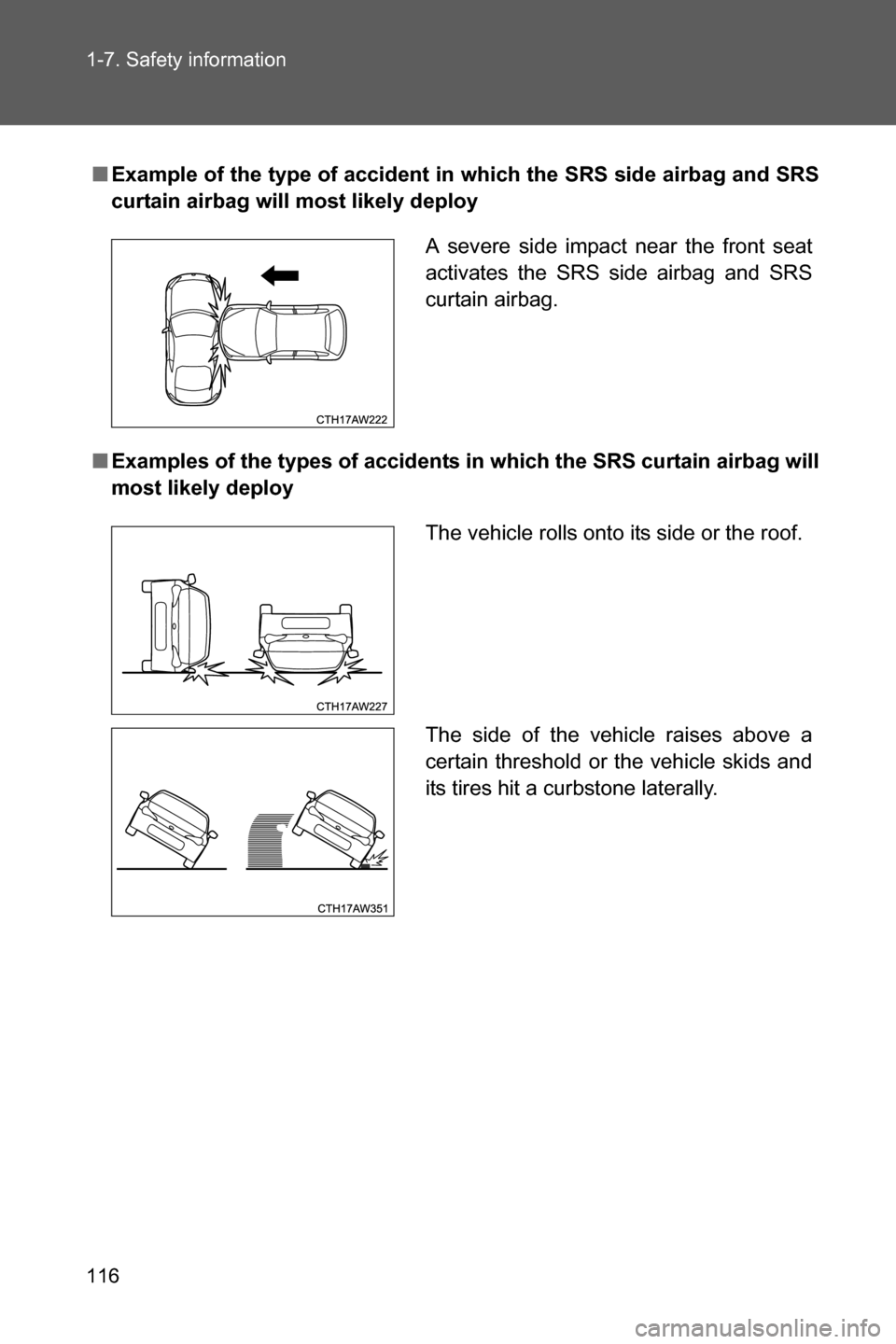
116 1-7. Safety information
■Example of the type of accident in which the SRS side airbag and SRS
curtain airbag will most likely deploy
■Examples of the types of accidents in which the SRS curtain airbag will
most likely deployA severe side impact near the front seat
activates the SRS side airbag and SRS
curtain airbag.
The vehicle rolls onto its side or the roof.
The side of the vehicle raises above a
certain threshold or the vehicle skids and
its tires hit a curbstone laterally.
Page 119 of 540
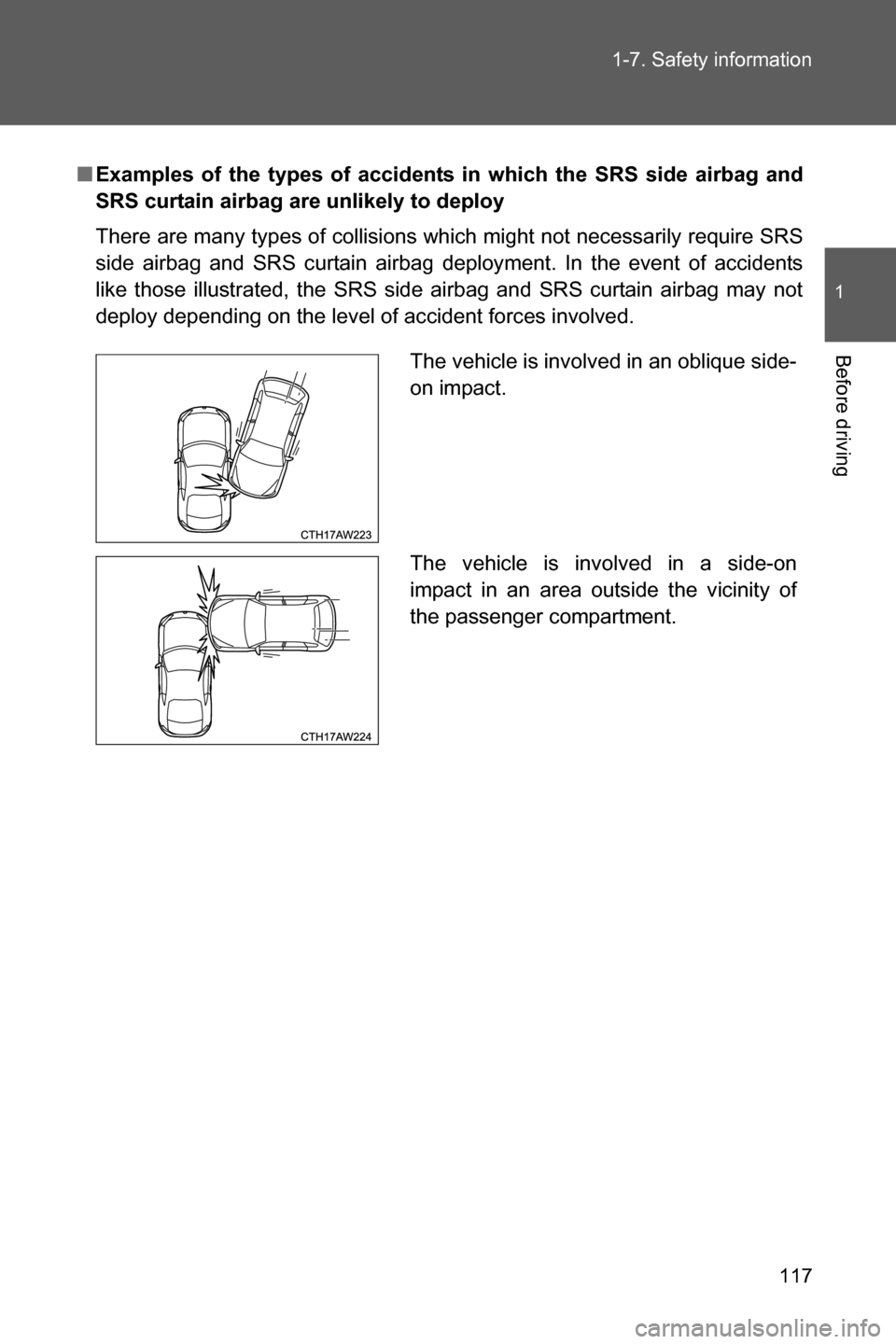
117 1-7. Safety information
1
Before driving
■Examples of the types of accidents in which the SRS side airbag and
SRS curtain airbag are unlikely to deploy
There are many types of collisions which might not necessarily require SRS
side airbag and SRS curtain airbag deployment. In the event of accidents
like those illustrated, the SRS side airbag and SRS curtain airbag may not
deploy depending on the level of accident forces involved.
The vehicle is involved in an oblique side-
on impact.
The vehicle is involved in a side-on
impact in an area outside the vicinity of
the passenger compartment.
Page 120 of 540
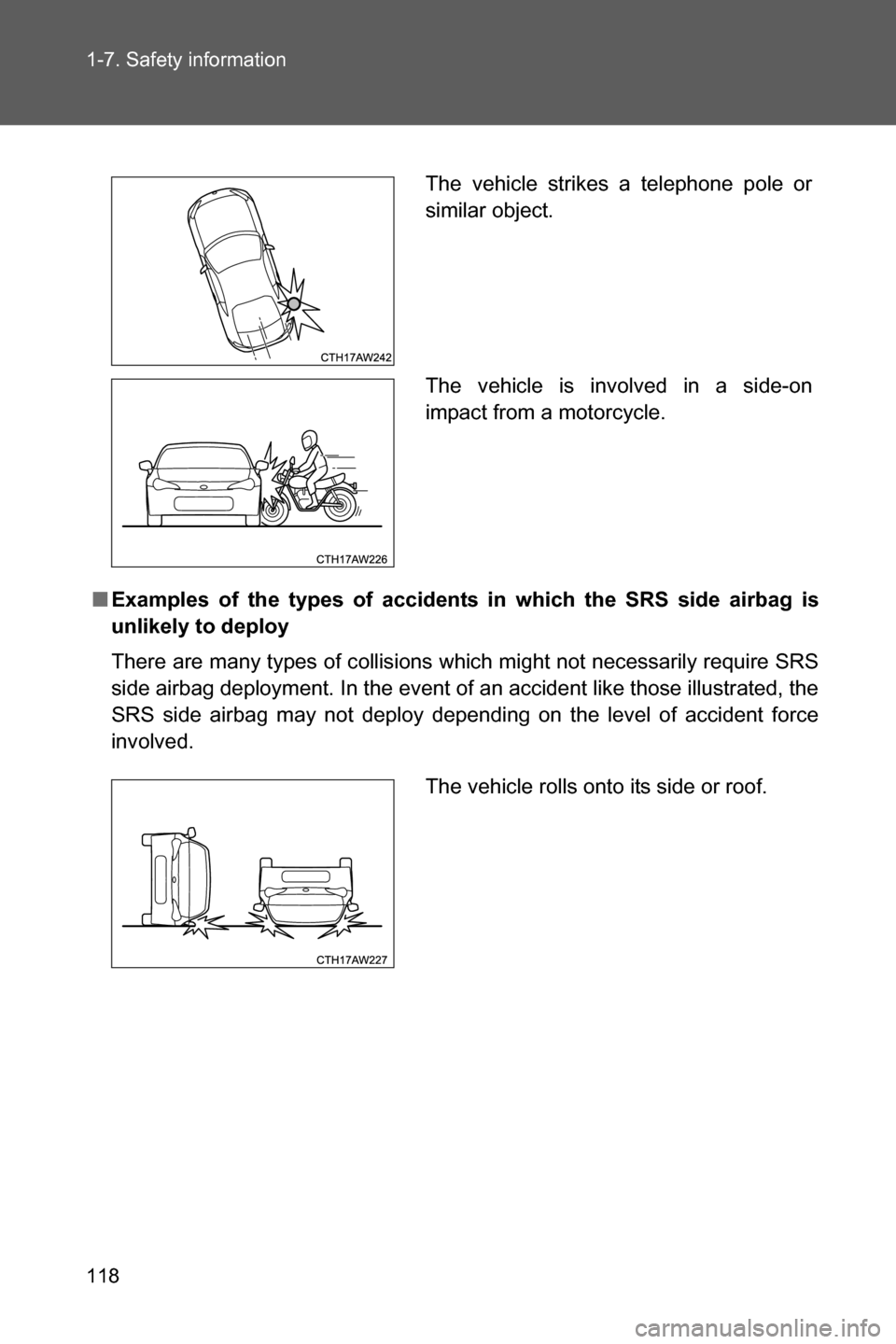
118 1-7. Safety information
■Examples of the types of accidents in which the SRS side airbag is
unlikely to deploy
There are many types of collisions which might not necessarily require SRS
side airbag deployment. In the event of an accident like those illustrated, the
SRS side airbag may not deploy depending on the level of accident force
involved.The vehicle strikes a telephone pole or
similar object.
The vehicle is involved in a side-on
impact from a motorcycle.
The vehicle rolls onto its side or roof.